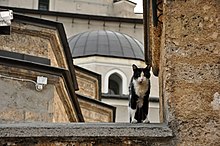Islam and cats

The cat is considered "the quintessential pet" by many Muslims,[1] and is admired for its cleanliness.
Unlike many other animals, such as dogs, Islamic Law considers cats ritually pure and that cats possess barakah (blessings),[2][3] and allows cats to freely enter homes and even mosques. Cats are believed to be the most common pet in Muslim countries.[1]
History
[edit]
The American poet and travel author Bayard Taylor (1825–1878) was astonished when he discovered a Syrian hospital where cats roamed freely. The institution, in which domestic felines were sheltered and nourished, was funded by a waqf, along with caretakers' wages, veterinary care, and cat food. Edward William Lane (1801–1876), a British Orientalist who resided in Cairo, described a cat garden originally endowed by the 13th-century Egyptian sultan Baibars.[1]
Wilfred Thesiger, in his book The Marsh Arabs, notes that cats were allowed free entry to community buildings in villages in the Mesopotamian Marshes and were even fed.[4][page needed] Aside from protecting granaries and food stores from pests, cats were valued by the paper-based Arab-Islamic cultures for preying on mice that destroyed books. For that reason, cats are often depicted in paintings alongside Islamic scholars and bibliophiles.
Hygiene and neutering
[edit]In Islamic tradition, cats are admired for their cleanliness. They are considered to be ritually clean, and are thus allowed to enter homes[1] and even mosques, including Masjid al-Haram. Food sampled by cats is considered halal, in the sense that their consumption of the food does not make it impermissible for Muslims to eat, and water from which cats have drunk is permitted for wudu (the ablution that is done by Muslims).[1]
Muslim scholars are divided on the issue of neutering animals. Most, however, maintain that neutering cats is allowed "if there is some benefit in neutering the cat and if that will not cause its death".[5] Muhammad ibn al Uthaymeen, a 20th-century Saudi Arabian Wahhabi imam, preached:
If there are too many cats and they are a nuisance, and if the operation will not harm them, then there is nothing wrong with it, because this is better than killing them after they have been created. But if the cats are ordinary cats and are not causing a nuisance, perhaps it is better to leave them alone to reproduce.[5]
Muezza
[edit]According to one story, Muhammad had a cat named Muezza (or Muʿizza; Arabic: معزة). While preparing for prayer, Muhammad discovered Muezza on his prayer robe, so he cut the sleeve off as to not disturb the cat.[6][7]
However, there is no mention of any such cat or story in any hadith,[8] which has led many Muslims to consider this story untrue.[9]
Assim Al-Hakeem, a Sunni cleric, comments on a question made about Muezza: [10]
But to claim that the prophet had a cat and he named it "Mu'izza" and the prophet did this or that, all of this is nonsense and baseless.
Sayyed Mohammad Al-Musawi, a Shia cleric, also comments on a question about Muezza, in which he says: [11]
About the name of a cat in the house of the Prophet, the narration is found in Sunni books, but I could not find it till now in our Shia books. It make no difference as the Hadeeths which we have are authentic in allowing having a cat at home.
Whether the story of Muezza is true or fabricated, Muhammad is known to have criticized abusers of cats.[12]
See also
[edit]- Cultural depictions of cats
- Feral cats in Istanbul
- Human interaction with cats
- Moral status of animals in the ancient world
References
[edit]- ^ a b c d e Campo, Juan Eduardo (2009). Encyclopedia of Islam. Infobase Publishing. p. 131. ISBN 978-0-8160-5454-1.
- ^ Mufti Menk (2022-09-06). Are cats pure? Mufti Menk. Retrieved 2024-08-30 – via YouTube.
- ^ Eisenstein, H. (2015). "Cat". In Fleet, Kate; Krämer, Gudrun; Matringe, Denis; Nawas, John; Rowson, Everett (eds.). Encyclopaedia of Islam (3rd ed.). Brill Online. doi:10.1163/1573-3912_ei3_COM_27599. ISSN 1873-9830.
- ^ Thesiger, Wilfred (1964). The Marsh Arabs. London: Longmans.
- ^ a b Abdul-Rahman, Muhammad Saed (2004). "Chapter 13: Transactions Animal Rights". Islam: Questions and Answers—Jurisprudence and Islamic Rulings: General and Transactions, Part 1. Vol. 22. Herne Hill, London, UK: MSA Publication Limited. pp. 323–325. ISBN 1-86179-411-8.
- ^ Geyer, Georgie Anne (2004). When Cats Reigned Like Kings: On the Trail of the Sacred Cats. Kansas City, Missouri: Andrews McMeel Publishing. p. 28. ISBN 0-7407-4697-9.
In still another charming legend about the Prophet, one day his favorite cat Muezza bowed to thank him for some kind favor and, by this story, Muhammad then passed his hand down three times the length of the animal's back, giving to it—and to all cats evermore—the enviable capacity always to land squarely on their feet.
- ^ Stall, Sam (2007). 100 Cats Who Changed Civilization: History's Most Influential Felines. Quirk Books. p. 40. ISBN 978-1-59474-163-0.
- ^ Motala, Moulana Suhail (2020-11-25). "Did Nabi (sallallahu 'alayhi wa sallam) have a cat named Muezza?". Hadith Answers. Retrieved 2021-03-15.
- ^ "The Prophet's cat Muezza". Islamic Portal. 2020-10-09. Retrieved 2021-03-15.
- ^ assimalhakeem (2022-04-20). Did Prophet have a cat named Muezza? Is having cats as pets a sunnah? - Assim al hakeem. Retrieved 2024-08-30 – via YouTube.
- ^ "I have heard that Rasulullah (saw) had a cat by the name of Muezza. Is this correct?". www.al-islam.org. 2021-10-06. Retrieved 2024-08-30.
- ^ "حديث الرسول عن القطط - حديث شريف". hadeethshareef.com (in Arabic). Retrieved 2024-03-29.
عُذِّبَتِ امْرَأَةٌ في هِرَّةٍ سَجَنَتْها حتَّى ماتَتْ، فَدَخَلَتْ فيها النَّارَ، لا هي أطْعَمَتْها ولا سَقَتْها، إذْ حَبَسَتْها، ولا هي تَرَكَتْها تَأْكُلُ مِن خَشاشِ الأرْضِ
